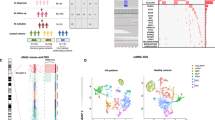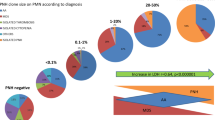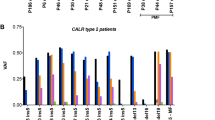Abstract
To clarify some characteristics of phosphatidylinositol glycan-class A gene (PIG-A) mutations in aplastic anemia (AA) and myelodysplastic syndrome (MDS) patients compared with those in paroxysmal nocturnal hemoglobinuria (PNH) patients, we investigated PIG-A mutations in CD59− granulocytes and CD48− monocytes from seven AA, eight MDS, and 11 PNH Japanese patients. The most frequent base or type abnormalities of the PIG-A gene in AA and MDS patients were base substitutions or missense mutations, respectively, and deletions or frameshift mutations, respectively, in PNH patients. Several PIG-A mutations, most of which were statistically minor, were found in glycosylphosphatidylinositol-negative cells from all AA and MDS patients but not from all PNH patients. However, the common PIG-A mutations during the clinical course between CD59− granulocytes and/or CD48− monocytes from each AA or MDS patient, except for Case 5, were not found. PIG-A mutations were different between the granulocytes and monocytes from five AA and five MDS patients. Our results indicate that there were some characteristics of PIG-A mutations in AA and MDS patients compared with PNH patients and that several minor PNH clones in these patients occurred at random during the clinical course. This partly explains the transformation of AA or MDS to PNH at intervals.
This is a preview of subscription content, access via your institution
Access options
Subscribe to this journal
Receive 12 print issues and online access
$259.00 per year
only $21.58 per issue
Buy this article
- Purchase on Springer Link
- Instant access to full article PDF
Prices may be subject to local taxes which are calculated during checkout
Similar content being viewed by others
References
Takeda J, Miyata T, Kawagoe K, Iida Y, Endo Y, Fujita T et al. Deficiency of the GPI anchor caused by a somatic mutation of the PIG-A gene in paroxysmal nocturnal hemoglobinuria. Cell 1993; 73: 703–711.
Miyata T, Takeda J, Iida Y, Yamada N, Inoue N, Takahashi M et al. The cloning of PIG-A, a component in the early step of GPI-anchor biosynthesis. Science 1993; 259: 1318–1320.
Shichishima T, Noji H . A new aspect of the molecular pathogenesis of paroxysmal nocturnal hemoglobinuria. Hematology 2002; 7: 211–227.
Young NS . The problem of clonality in aplastic anemia: Dr Dameshek's riddle, restated. Blood 1992; 79: 1385–1392.
Schubert J, Vogt HG, Zielinska-Skowronek M, Freund M, Kaltwasser JP, Hoelzer D et al. Development of the glycosylphosphatidylinositol-anchoring defect characteristic for paroxysmal nocturnal hemoglobinuria in patients with aplastic anemia. Blood 1994; 83: 2323–2328.
Schrezenmeier H, Hertenstein B, Wagner B, Raghavachar A, Heimpel H . A pathogenetic link between aplastic anemia and paroxysmal nocturnal hemoglobinuria is suggested by a high frequency of aplastic anemia patients with a deficiency of phosphatidylinositol glycan anchored proteins. Exp Hematol 1995; 23: 81–87.
Tooze JA, Saso R, Marsh JCW, Papadopoulos A, Pulford K, Gordon-Smith EC . The novel monoclonal antibody By114 helps detect the early emergence of a paroxysmal nocturnal hemoglobinuria clone in aplastic anemia. Exp Hematol 1995; 23: 1484–1491.
Yamaguchi M, Nakao S, Takamatsu H, Chuhjo T, Shiobara S, Matsuda T . Quality of hematologic recovery in patients with aplastic anemia following cyclosporine therapy. Exp Hematol 1995; 23: 341–346.
Griscelli-Bennaceur A, Gluckman E, Scrobohaci ML, Jonveaux P, Vu T, Bazarbachi A et al. Aplastic anemia and paroxysmal nocturnal hemoglobinuria: search for a pathogenetic link. Blood 1995; 85: 1354–1363.
De Lord C, Tooze JA, Saso R, March JCW, Gordon-Smith EC . Deficiency of glycosilphosphatidyl inositol-anchored proteins in patients with aplastic anaemia does not affect response to immunosuppressive therapy. Br J Haematol 1998; 101: 90–93.
Azenishi Y, Ueda E, Machii T, Nishimura J, Hirota T, Shibano M et al. CD59-deficient blood cells and PIG-A gene abnormalities in Japanese patients with aplastic anaemia. Br J Haematol 1999; 104: 523–529.
Dunn DE, Tanawattanacharoen P, Boccuni P, Nagakura S, Green SW, Kirby MR et al. Paroxysmal nocturnal hemoglobinuria cells in patients with bone marrow failure syndromes. Ann Intern Med 1999; 131: 401–408.
Piaggio G, Podestà M, Pitto A, Sessarego M, Figari O, Fugazza G et al. Coexistence of normal and clonal haemopoiesis in aplastic anaemia patients treated with immunosuppressive therapy. Br J Haematol 1999; 107: 505–511.
Wang H, Chuhjo T, Yamazaki H, Shiobara S, Teramura M, Mizoguchi H et al. Relative increase of granulocytes with a paroxysmal nocturnal haemoglobinuria phenotype in aplastic anaemia patients: the high prevalence at diagnosis. Eur J Haematol 2001; 66: 200–205.
Iwanaga M, Furukawa K, Amenomori T, Mori H, Nakamura H, Fuchigami K et al. Paroxysmal nocturnal haemoglobinuria clones in patients with myelodysplastic syndromes. Br J Haematol 1998; 102: 465–474.
Meletis J, Terpos E, Samarkos M, Meletis C, Konstantopoulos K, Komninaka V et al. Detection of CD55 and/or CD59 deficient red cell populations in patients with aplastic anaemia, myelodysplastic syndromes and myeloproliferative disorders. Haematologia 2001; 31: 7–16.
Wang H, Chuhjo T, Yasue S, Omine M, Nakao S . Clinical significance of a minor population of paroxysmal nocturnal hemoglobinuria-type cells in bone marrow failure syndrome. Blood 2002; 100: 3897–3902.
Kawaguchi K, Wada H, Mori A, Takemoto Y, Kakishita E, Kanamaru A . Detection of GPI-anchored protein-deficient cells in patients with aplastic anaemia and evidence for clonal expansion during the clinical course. Br J Haematol 1999; 105: 80–84.
Mortazavi Y, Merk B, McIntosh J, Marsh JCW, Schrezenmeier H, Rutherford TR . The spectrum of PIG-A gene mutations in aplastic anemia/paroxysmal nocturnal hemoglobinuria (AA/PNH): a high incidence of multiple mutations and evidence of a mutational hot spot. Blood 2003; 101: 2833–2841.
International Agranulocytosis and Aplastic Anemia Study. Incidence of aplastic anemia: The relevance of diagnostic criteria. Blood 1987; 70: 1718–1721.
Frickhofen N, Kaltwasser JP, Schrezenmeier H, Raghavachar A, Vogt HG, Herrmann F et al. Treatment of aplastic anemia with antilymphocyte globulin and methylprednisolone with or without cyclosporine. N Engl J Med 1991; 324: 1297–1304.
Bennett JM, Catovsky D, Daniel MT, Flandrin G, Galton DA, Gralnick HR et al. The French-American-British (FAB) Co-operative Group. Proposals for the classification of the myelodysplastic syndromes. Br J Heamatol 1982; 51: 189–199.
Shichishima T, Terasawa T, Hashimoto C, Ohto H, Uchida T, Maruyama Y . Heterogenous expression of decay accelerating factor and CD59/membrane attack complex inhibition factor on paroxysmal nocturnal haemoglobinuria (PNH) erythrocytes. Br J Haematol 1991; 78: 545–550.
Hall SE, Rosse WF . The use of monoclonal antibodies and flow cytometry in the diagnosis of paroxysmal nocturnal hemoglobinuria. Blood 1996; 87: 5332–5340.
Lewis SM, Dacie JP . The aplastic anaemia-paroxysmal nocturnal haemoglobinuria syndrome. Br J Haematol 1967; 13: 236–251.
Sugita Y, Mazda T, Tomita M . Amino-terminal amino acid sequence and chemical and functional properties of a membrane attack complex-inhibitory factor from human erythrocyte membranes. J Biochem 1989; 106: 589–592.
Shichishima T, Terasawa T, Saitoh Y, Hashimoto C, Ohto H, Maruyama Y . Diagnosis of paroxysmal nocturnal haemoglobinuria by phenotypic analysis of erythrocytes using two-colour flow cytometry with monoclonal antibodies to DAF and CD59/MACIF. Br J Haematol 1993; 85: 378–386.
Noji H, Shichishima T, Saitoh Y, Kai T, Yamamoto T, Ogawa K et al. The distribution of PIG-A gene abnormalities in paroxysmal nocturnal hemoglobinuria granulocytes and cultured erythroblasts. Exp Hematol 2001; 29: 391–400.
Kai T, Shichishima T, Noji H, Yamamoto T, Okamoto M, Ikeda K et al. Phenotypes and phosphatidylinositol glycan-class A gene abnormalities during cell differentiation and maturation from precursor cells to mature granulocytes in patients with paroxysmal nocturnal hemoglobinuria. Blood 2002; 100: 3812–3818.
Iida Y, Takeda J, Miyata T, Inoue N, Nishimura J, Kitani T et al. Characterization of genomic PIG-A gene: a gene for glycosylphosphatidylinositol-anchor biosynthesis and paroxysmal nocturnal hemoglobinuria. Blood 1994; 83: 3126–3131.
Araten DJ, Nafa K, Pakdeesuwan K, Luzzatto L . Clonal populations of hematopoietic cells with paroxysmal nocturnal hemoglobinuria genotype and phenotype are present in normal individuals. Proc Natl Acad Sci USA 1999; 96: 5209–5214.
Hu R, Mukhina GL, Piantadosi S, Barber JP, Jones RJ, Brodsky RA . PIG-A mutations in normal hematopoiesis. Blood 2005; 105: 3848–3854.
Luzzatto L, Bessler M . The dual pathogenesis of paroxysmal nocturnal hemoglobinura. Curr Opin Hematol 1996; 3: 101–110.
Nishimura J, Hirota T, Kanakura Y, Machii T, Kageyama T, Doi S et al. Long-term support of hematopoiesis by a single stem cell clone in patients with paroxysmal nocturnal hemoglobinuria. Blood 2002; 99: 2748–2751.
Acknowledgements
We thank Dr Teizo Fujita (Department of Biochemistry II, Fukushima Medical University, Japan), Dr Mitsuru Munakata (Department of Pulmonary Medicine, Fukushima Medical University, Japan), Dr Ikuo Wada (Department of Cell Science, Institute of Biomedical Science, Fukushima Medical University, Japan), and Ms Sayuri Mizuno (Fukushima Medical University, Japan) for their valuable assistance. We are also grateful to Dr Kazuei Ogawa (Fukushima Medical University, Japan), Dr Kenji Nagata, Dr Yurie Saitoh, Dr Hiroyuki Kanbayashi and Dr Shin Matsuda (Ohta Nishino-uchi Hospital, Japan), Dr Tatsuyuki Kai and Dr Hideo Kimura (General Hobara-chuoh Hospital, Japan), Dr Rokuo Abe (Fukushima-ken Taiyo-no-kuni Hospital, Japan), Dr Masayuki Mita (Hoshi General Hospital, Japan), and Dr Kenichi Nakamura (Shirakawa-kosei Hospital, Japan) for providing the samples from patients with AA and MDS. We are indebted to Dr Yuji Sugita (Showa University, Japan), who provided the monoclonal antibody to CD59/membrane attack complex-inhibitory factor.
This study was supported in part by a Grant-in-aid for Medical Research from the Fukushima Prefectural Hospitals (No. 160) and a Grant-in-aid from the Fukushima Society for the Promotion of Medicine (No. 14–32) to TS.
Author information
Authors and Affiliations
Corresponding author
Rights and permissions
About this article
Cite this article
Okamoto, M., Shichishima, T., Noji, H. et al. High frequency of several PIG-A mutations in patients with aplastic anemia and myelodysplastic syndrome. Leukemia 20, 627–634 (2006). https://doi.org/10.1038/sj.leu.2404135
Received:
Revised:
Accepted:
Published:
Issue Date:
DOI: https://doi.org/10.1038/sj.leu.2404135
Keywords
This article is cited by
-
Diagnostik der PNH
InFo Hämatologie + Onkologie (2024)
-
Minor GPI(-) granulocyte populations in aplastic anemia and healthy individuals derived from a few PIGA-mutated hematopoietic stem progenitor cells
Blood Cancer Journal (2023)
-
Low concentration of serum haptoglobin has impact on understanding complex pathophysiology in patients with acquired bone marrow failure syndromes
International Journal of Hematology (2010)
-
Differential gene expression of bone marrow-derived CD34+ cells is associated with survival of patients suffering from myelodysplastic syndrome
International Journal of Hematology (2009)
-
Detection of CD55- and CD59-deficient granulocytic populations in patients with myelodysplastic syndrome
Annals of Hematology (2008)



